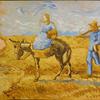John Wilson: Prints & Drawings at Martha Richardson Fine Art, Boston
- BOSTON, Massachusetts
- /
- March 26, 2010

Martha Richardson Fine Art, Boston is pleased to announce the exhibition “John Wilson: Prints & Drawings,” a collection of the artist’s works on paper dating from 1943 to 2004.
John Wilson’s artistic development and his achievements are profoundly intertwined with his compassion for the oppressed and his commitment to social progress. Observing and experiencing injustice himself, John Wilson devoted his considerable talents to address the painful realities of racial prejudice.
John Wilson, a skilled painter, sculptor and printmaker, was born in Roxbury, Massachusetts in 1922. After his work was brought to the attention of the School of the Museum of Fine Arts, Boston, Wilson received a full scholarship. The earliest work of art in the exhibition, a rare impression of Wilson’s 1943 lithograph Grief, attests to the artist’s knowledge of the socially conscious Mexican artist José Clemente Orozco. Orozco’s deep connection to the plight of the underclass was an important revelation for the young Wilson. By his early 20s, Wilson’s work had been shown in several gallery exhibitions, had won numerous awards, and appeared in a number of prestigious magazines.

Wilson graduated from the Museum School in 1945 with the highest honors and in the same year, a piece was included in the exhibition “The Negro Artist Comes of Age” at the Albany Institute of History and Art. A number of works from this early period are included in the current show: Mother and Child and Native Son, one of Wilson’s best known prints in which he portrays Bigger Thomas, the protagonist of Richard Wright’s 1940 novel Native Son. In addition, two rare 1947 lithographs are included, Street Scene and Straphangers, both paired with their original ink studies.
That same year, 1947, Wilson received the prestigious James William Paige Traveling Fellowship. He moved to Paris and worked in Fernand Léger’s studio, a formative experience for Wilson. Under Léger, Wilson expanded upon the formal lessons learned at the Museum School and further explored elements of composition: line, shape, color, and form, as evidenced in the color lithograph Boulevard de Strasbourg in this exhibition.
After returning to America, Wilson participated in the “Third Annual Atlanta University Exhibition,” the only national exhibition for African-American artists at that time. He continued to show at Atlanta University where he was awarded numerous honors. In 1950, another of Wilson’s works was included in the “Young American Painters” exhibition at the Metropolitan Museum of Art, New York. That year, Wilson received the John Hay Whitney Fellowship, enabling him to move to Mexico City. There, he continued his artistic education and studied the works of the great Mexican muralists who were creating large-scale public art with powerful political messages.

In Mexico, as in Paris, Wilson felt free of the racial prejudice that he experienced in the United States. However, he was keenly aware and increasingly disturbed by news reports from the States, including pervasive persecution of African American men. During this period, Wilson painted The Incident, a mural depicting a lynching, and made The Trial, a lithograph included in the current exhibition in which a young black boy stands before three white judges (wearing theatrical masks) who loom menacingly above. Wilson made prints at the renowned workshop, the Taller de Gráfica Popular, where Mexican artists and other like-minded American artists, such as Charles White and Elizabeth Catlett, were producing prints of socially conscious subjects. The current exhibition includes a strong selection of lithographs from this period: Mexican Woman, La Calle, Dialogue and Trabajador.
Wilson returned to the States in 1956, first to Chicago and then to teach at the Pratt Institute, New York. He remained politically active, providing artistic support to radical publications and various organizations working for change. Wilson held this position until 1964 when he returned to Boston to accept a position as art professor at Boston University.
John Wilson is celebrated for his use of dark tones to create an intensely sculptural quality to his drawings and prints. In the 1970s, Wilson was chosen to create a sculpted bronze memorial of Martin Luther King, Jr. for the United States Capitol. His famous etching of Martin Luther King, Jr. is on view in the gallery along side other recent works such as Monumental Head and Head of a Woman. Wilson continues to sculpt and draw and is currently working on a sculpture commission for Yale University.
Martha Richardson Fine Art is located at 38 Newbury Street, Boston. For further information, please call us at 617-266-3321 or visit web site at MarthaRichardsonFineArt.com.





100x100_c.jpg)


5100x100_c.jpg)






